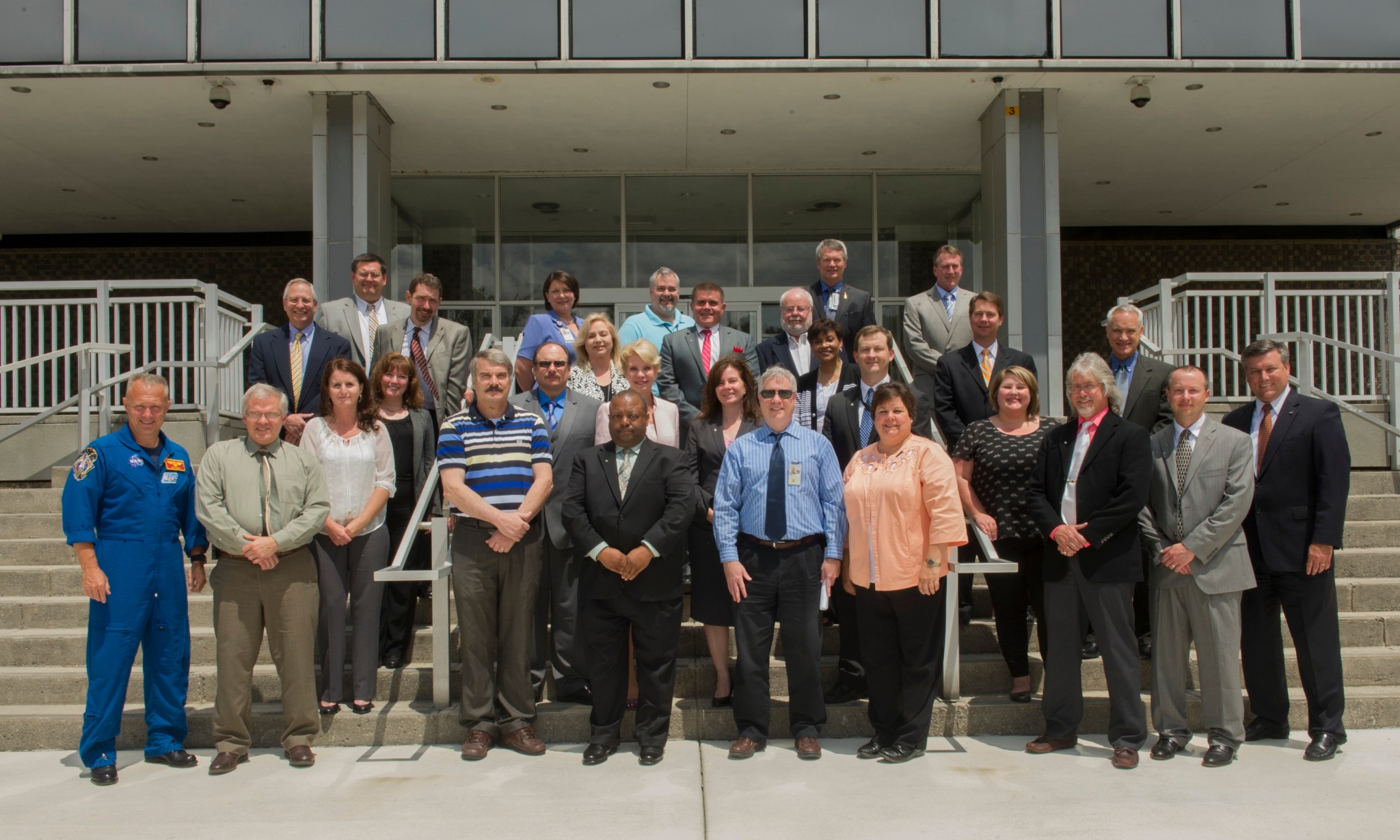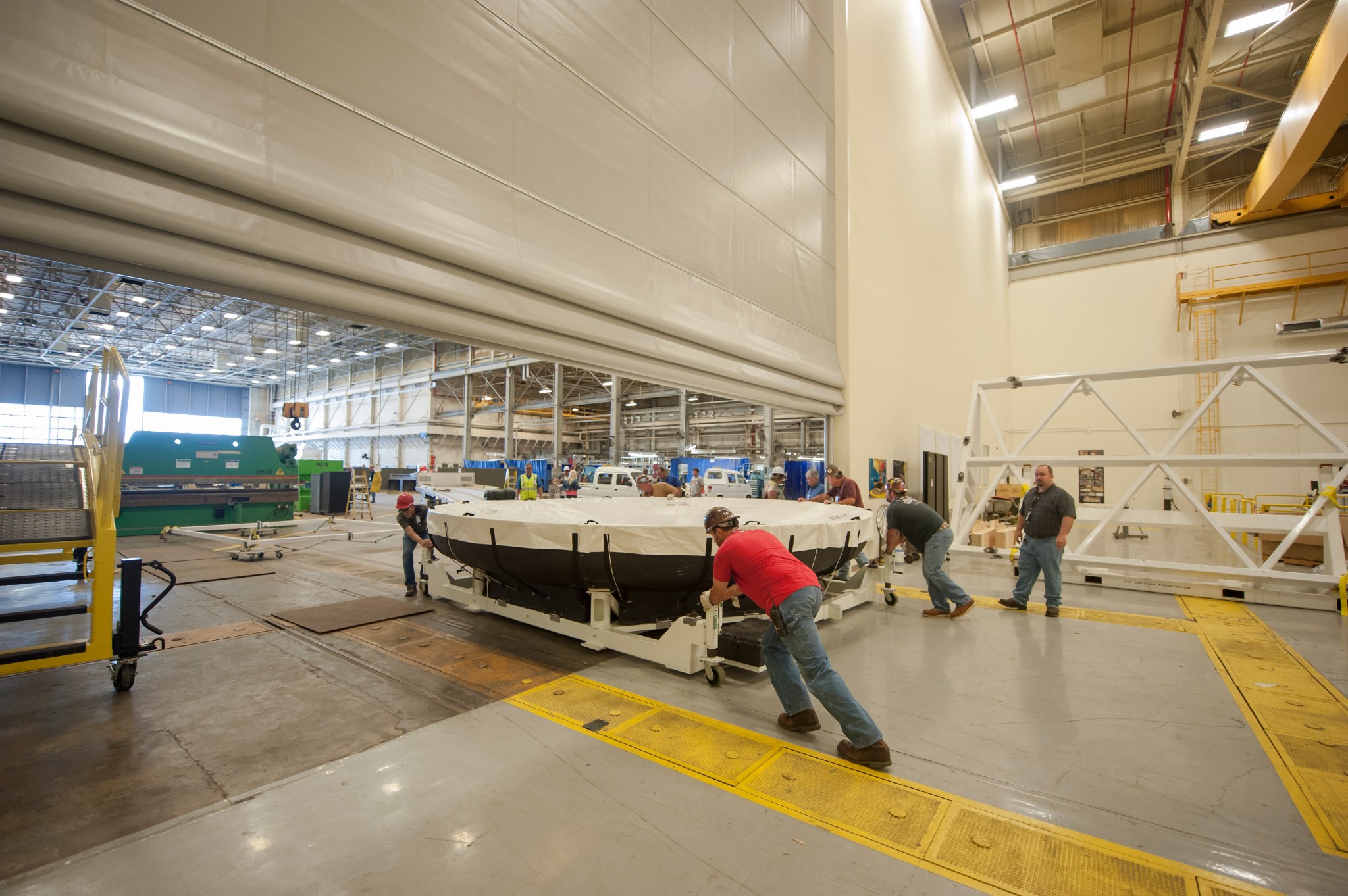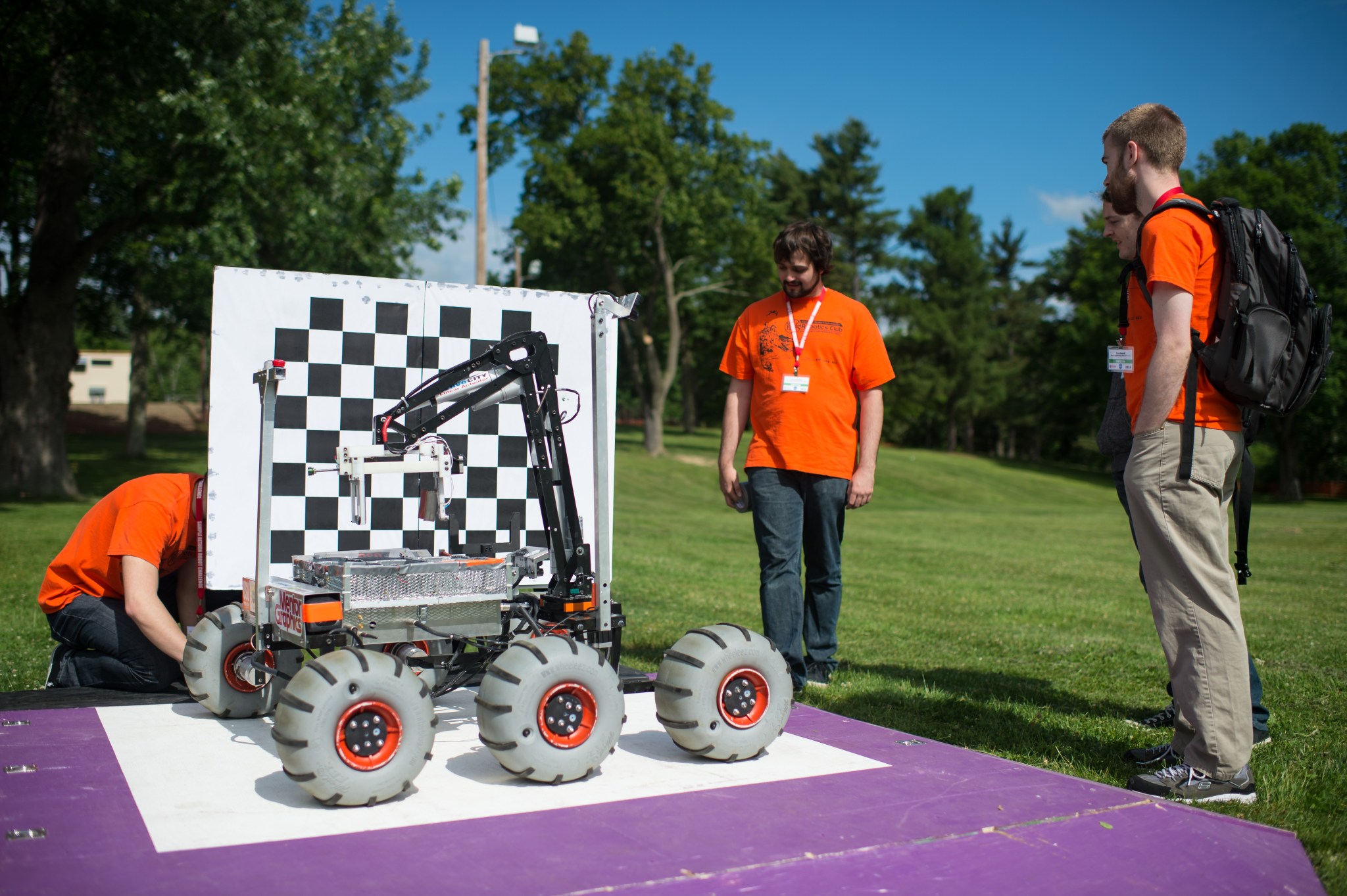In This Week’s Star
- › NASA’s Supersonic Decelerator Project Completes Second Flight Test
- › NASA Honors Marshall Team Members with Silver Snoopy Awards
- › Orion Heat Shield Work Wraps at Marshall
- › NASA Social Event Highlights Upcoming Pluto Flyby for New Horizons Mission
- › Robotics Teams Compete for $1.5 Million at NASA’s Sample Return Robot Challenge
- › Schedule of Events Available for ‘Take Our Children to Work Day’ June 18
- › Marshall Team Members Invited to NASA on the Square June 20
- › New Data On Plutonian Moons Featured On ‘This Week @NASA’
NASA’s Supersonic Decelerator Project Completes Second Flight Test
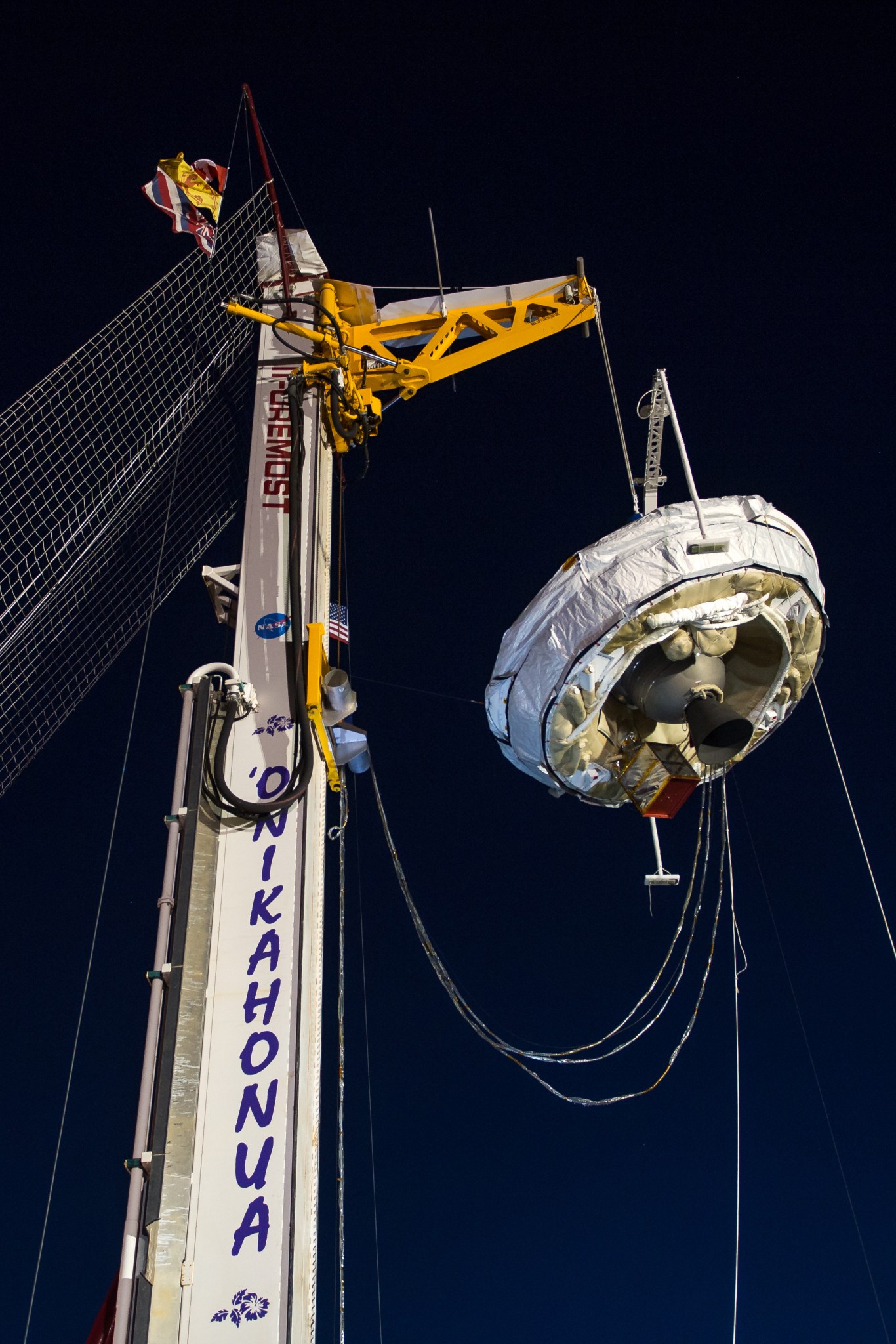
Engineers are poring over the data following the second experimental landing technology test of NASA’s Low-Density Supersonic Decelerator project. The saucer-shaped craft splashed down at 4:49 p.m. CDT June 8 in the Pacific Ocean off the west coast of the Hawaiian island of Kauai.
During this flight, the project team tested two decelerator technologies that could enable larger payloads to land safely on the surface of Mars, and allow access to more of the planet’s surface by assisting landings at higher-altitude sites.
“Developing and demonstrating entry, descent and landing technologies such as supersonic decelerators is critical to enabling our journey to Mars,” said Steve Jurczyk, associate administrator for the Space Technology Mission Directorate at NASA Headquarters. “The technologies tested on LDSD are giving us data and insight into the capabilities we’ll need to land more mass than we currently can on Mars, which will enable more capable robotic missions, as well as human precursor missions to the Red Planet.”
A high-altitude balloon carrying the test vehicle launched at 7:45 a.m., Hawaii time, from the U.S. Navy’s Pacific Missile Range Facility on Kauai. As planned, at 11:35 a.m., the vehicle separated from the balloon at about 120,000 feet above the ocean. An onboard rocket motor then took the vehicle to 180,000 feet, where the first braking technology, the Supersonic Inflatable Aerodynamic Decelerator, deployed at about Mach 3 at 11:37 a.m.
Fourteen seconds after SIAD inflation, the test vehicle’s parachute was released into the supersonic slipstream, according to plan. Preliminary analysis of imagery and other data received during the test indicates the Supersonic Ringsail parachute deployed. This 100-foot-wide parachute, the largest supersonic parachute ever flown, has more than double the area of the parachute used for the Mars Science Laboratory mission that carried the Curiosity rover to the surface of Mars. The chute began to generate large amounts of drag and a tear appeared in the canopy at about the time it was fully inflated.
“Early indications are that we got what we came for, new and actionable data on our parachute design,” said Mark Adler, LDSD project manager at NASA’s Jet Propulsion Laboratory. “At present, our data is in the form of low-resolution video and some other nuggets of data which were downlinked in real-time. But this will soon change when our test vehicle makes port, and we have the opportunity to inspect the ultra-high resolution, high-speed imagery and other comprehensive information carried in the memory cards on board our saucer.”
Monday’s flight test was the second for the project. During the first flight in June 2014, the main goal was to demonstrate and operate the vehicle through its entire mission. That flight also carried the two LDSD braking technologies, and the SIAD worked perfectly during the first test. However, the supersonic parachute did not inflate as designed. With the data from last year’s test, the LDSD team developed a new formula for this year’s chute, making it stronger and more curved into its top to help it survive the initial shock of supersonic wind.
“The physics involved with LDSD is so cutting-edge we learn something profound every time we test,” said Ian Clark, LDSD principal investigator at the Jet Propulsion Laboratory. “Going into this year’s flight, I wanted to see that the parachute opened further than it did last year before it began to rupture. The limited data set we have at present indicates we may not only have gone well down the road to full inflation, but we may have achieved it.
“We also saw another successful inflation of our 20-foot SIAD and another successful deployment and inflation of our supersonic ballute — an inflatable drag device that extracts the parachute. Both of those devices have now had two great flights, and we have matured them to the point where they can be used, with confidence, on future missions,” Clark added. “We’re not just pushing the envelope. We flew a 7,000-pound test vehicle right through it.”
NASA expects to make high-resolution imagery and comprehensive data from the test available to the public in about two weeks.
NASA’s Space Technology Mission Directorate funds the LDSD mission, a cooperative effort led by the Jet Propulsion Laboratory. The Technology Demonstration Mission Program at NASA’s Marshall Space Flight Center manages the project for the agency. NASA’s Wallops Flight Facility coordinates range and safety support with the Pacific Missile Range Facility and provides the balloon systems for the flight test.
NASA Honors Marshall Team Members with Silver Snoopy Awards
On June 3, team members at NASA’s Marshall Space Flight Center were honored with the coveted Silver Snoopy award. The Silver Snoopy is presented by the NASA astronaut corps to outstanding civil-service and contractor employees who have significantly contributed to America’s human spaceflight program.
Marshall Director Patrick Scheuermann and NASA astronaut Doug Hurley, veteran of the STS-127 and STS-135 spaceflights, presented the awards to 16 Marshall team members during a ceremony in Morris Auditorium.
This was the first of three Silver Snoopy ceremonies scheduled in 2015. For more information about the award, click here.
Honorees included Jarod Andrews, Engineering Directorate; Amy Black, Office of Center Operations; Stacy Cook, Science and Technology Office; Mark Christl, Science and Technology Office; Robert Johnston, Coastal International Security; Danny Jones, Safety and Mission Assurance Directorate; Brent Knight, Engineering Directorate; Alan Murphy, Office of Center Operations; Kristopher McDougal, Engineering Directorate; Robin Osborne, Jacobs; Jonathan Patterson, Engineering Directorate; Walter Robinson, Engineering Directorate; Jenna Ruddock, Engineering Directorate; Dona Smith, Safety and Mission Assurance Directorate; Carole Valenti, Office of Center Operations; and Beth Young, Office of Human Capital.
Orion Heat Shield Work Wraps at Marshall
By Rick Smith
With the latest engineering and analysis work complete on the Orion crew module’s heat shield, engineers at NASA’s Marshall Space Flight Center packed up the 16.5-foot-diameter shield and on June 1 sent it by truck to NASA’s Langley Research Center for further testing.
This critical element of Orion — the spacecraft now in development by NASA to carry future astronauts on new missions of discovery — arrived at Marshall March 9. Engineers from Marshall, NASA’s Ames Research Center, NASA’s Johnson Space Center and Orion prime contractor Lockheed Martin collaborated to remove and analyze the heat shield’s ablative surface coating, which slowly burned away in the atmosphere to protect Orion during its successful 2014 flight test.
That roughly 11-week engineering effort relied heavily on Marshall’s state-of-the-art, seven-axis milling and machining facility. Researchers will study the ablated material and compare it to existing NASA computer models predicting how the heat shield will perform during future space missions.
A new Marshall time-lapse video depicts workers preparing the heat shield for its departure from the center.
The heat shield next will undergo water-impact testing at Langley.
Orion will launch atop the Space Launch System, the nation’s heavy-lift rocket currently in development. Visit NASA on the Web for more information about Orion and NASA’s journey to Mars.
Smith, an ASRC Federal/Analytical Services employee, supports the Office of Strategic Analysis & Communications.
NASA Social Event Highlights Upcoming Pluto Flyby for New Horizons Mission
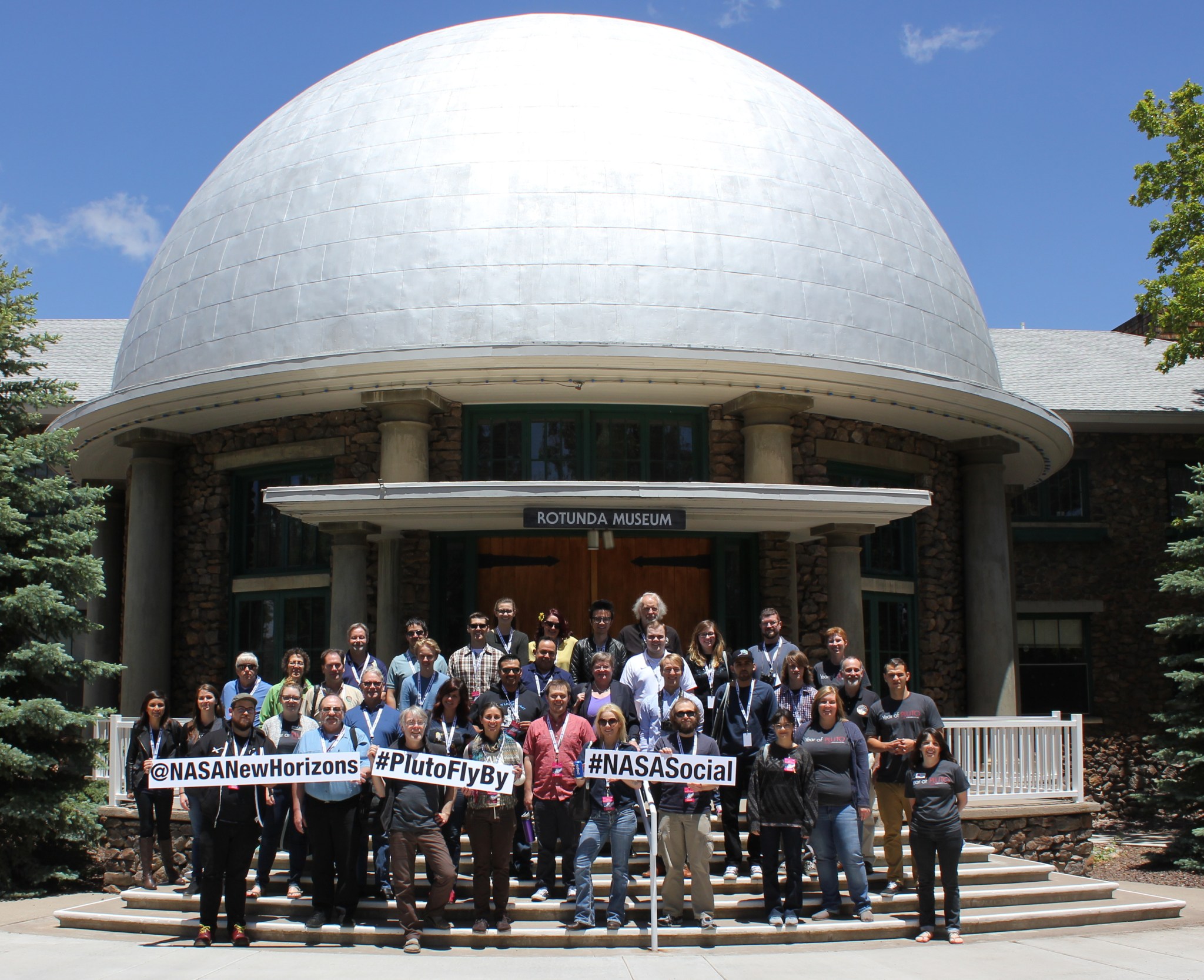
On June 6, a NASA social media event was held at the Lowell Observatory in Flagstaff, Arizona, to discuss the New Horizons spacecraft and its upcoming flyby of the dwarf planet Pluto, scheduled July 14. More than 30 NASA social media followers from across the country applied for and were selected to attend the event, at their own cost. Guest speakers included Dr. Will Grundy, astronomer at the Lowell Observatory; Olwen Morgan, business development manager with Aerojet Rocketdyne; Joseph Lazio, chief scientist for NASA’s Deep Space Network; and Brian Mitchell, communications manager for the Planetary Missions Program Office at NASA’s Marshall Space Flight Center. The New Horizons spacecraft is part of NASA’s New Frontiers program and is managed by Marshall. (NASA/MSFC/Christopher Blair)
Robotics Teams Compete for $1.5 Million at NASA’s Sample Return Robot Challenge
By Janet Sudnik
On June 8, 20 robotics teams — ranging from university students and makers to small businesses — began competition in the fourth running of the NASA Centennial Challenge program’s Sample Return Robot Challenge. The six-day event, which continues until June 13, is being held at Worcester Polytechnic Institute in Worcester, Massachusetts. The autonomous robot competition carries a prize purse of $1.5 million, with teams edging closer to a winning solution since the challenge’s inception in 2012.
Teams must demonstrate a robot that can locate and collect geologic samples from a large and varied landscape, without human control, through two levels of competition that grow in complexity. The objective is to encourage innovations in autonomous navigation and robotic manipulator technologies. Innovations stemming from this challenge may improve NASA’s capability to explore farther into space, as well as enhance the nation’s robotic technology for use in Earth applications.
“With missions to other planets and deeper space in our sights, it is increasingly valuable and necessary to see these technologies through,” said Sam Ortega, program manager for Centennial Challenges at NASA’s Marshall Space Flight Center. “Robots are our pioneers, and solving this challenge will be a breakthrough for future space exploration.”
At the first competition in 2012, no teams were awarded prize money. In 2013, NASA awarded $5,000 to Team Survey of Los Angeles for completing Level 1, and to the West Virginia Mountaineers of Morgantown in 2014 for the same. Survey and the Mountaineers will be eligible to begin the 2015 competition at Level 2, bypassing Level 1 if they choose.
Returning teams include Formicarum of Worcester, Massachusetts; Gather of Alexandria, Virginia; Lunambotics of Mexico City, Mexico; Middleman of Dunedin, Florida; the West Virginia University Mountaineers; Oregon State University of Corvallis; the Retrievers of Schenectady, New York; the Rensselaer Polytechnic Institute Rock Raiders of Troy, New York; Survey of Los Angeles; and Wunderkammer of Topanga, California.
New teams this year include Army of Angry Robots of Silicon Valley, California; DT Bozzelli of Ann Arbor, Michigan; MAXed OUT of San Jose, California; Mind + Iron of Needham, Massachusetts; Massachusetts Institute of Technology Robotics Team of Cambridge; RoboRetrievers of Tampa; Florida; Sirius of South Hadley, Massachusetts; Smart Move of Clearwater, Florida; Smart Tools of Gurnee, Illinois; and the National Autonomous University of Mexico.
The Centennial Challenges program is part of NASA’s Space Technology Mission Directorate, which seeks out the best and brightest minds in academia, industry and government to drive innovation and enable solutions in important technology focus areas.
The Sample Return Challenge will be broadcast live on Marshall’s Ustream channel.
Sudnik, an ASRC Federal/Analytical Services employee, supports the Office of Strategic Analysis & Communications.
Schedule of Events Available for ‘Take Our Children to Work Day’ June 18
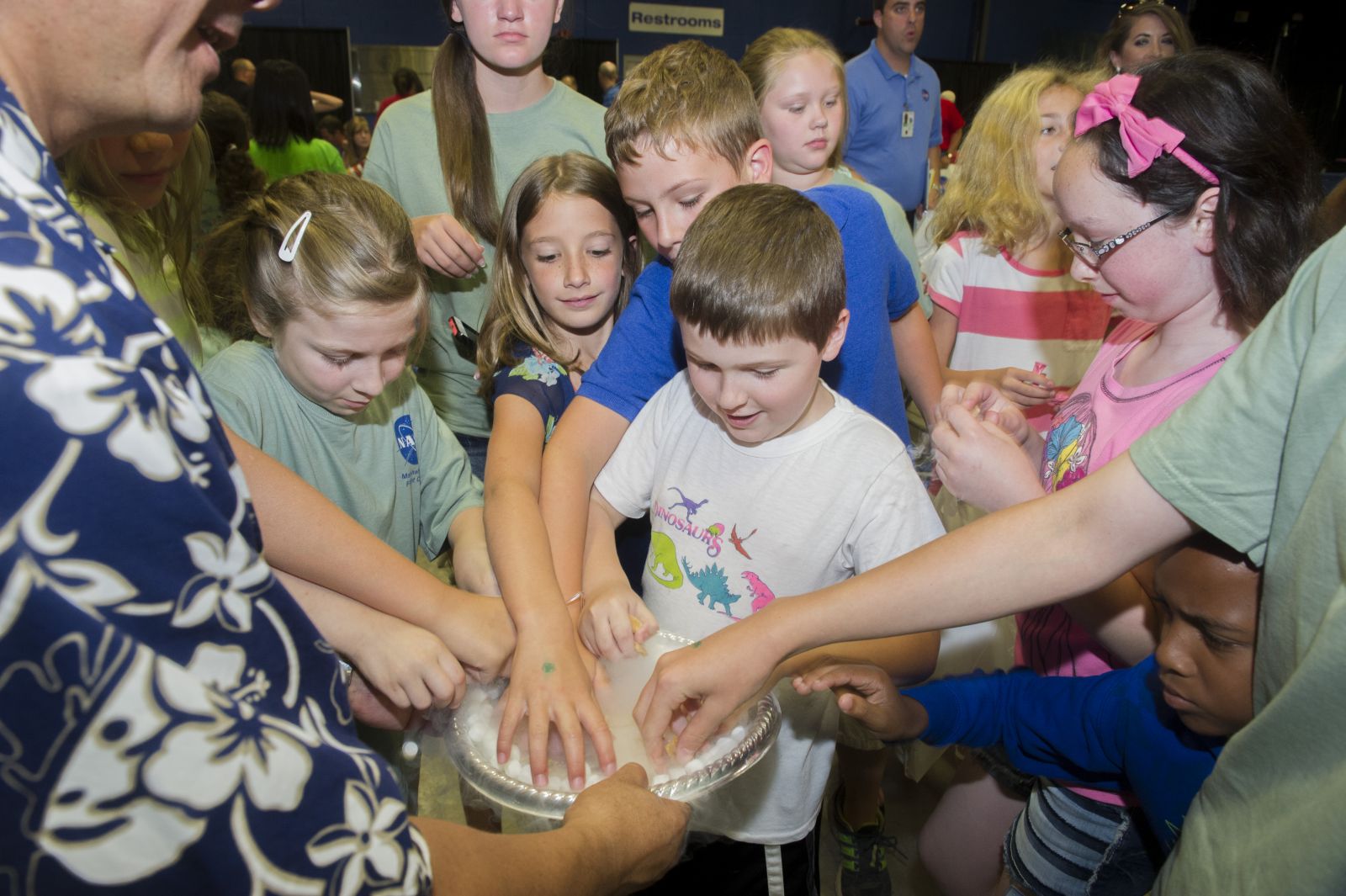
NASA’s Marshall Space Flight Center will host “Take Our Children to Work Day” June 18. The schedule of events for the day, available here, includes many exciting presentations, experiments, crafts and more. Marshall civil service employees and contractors are encouraged to bring their children, grades 3-12, to the center to participate in a series of fun, hands-on, educational activities and to learn more about the interesting and exciting work accomplished here. (NASA/MSFC/Emmett Given)
Marshall Team Members Invited to NASA on the Square June 20
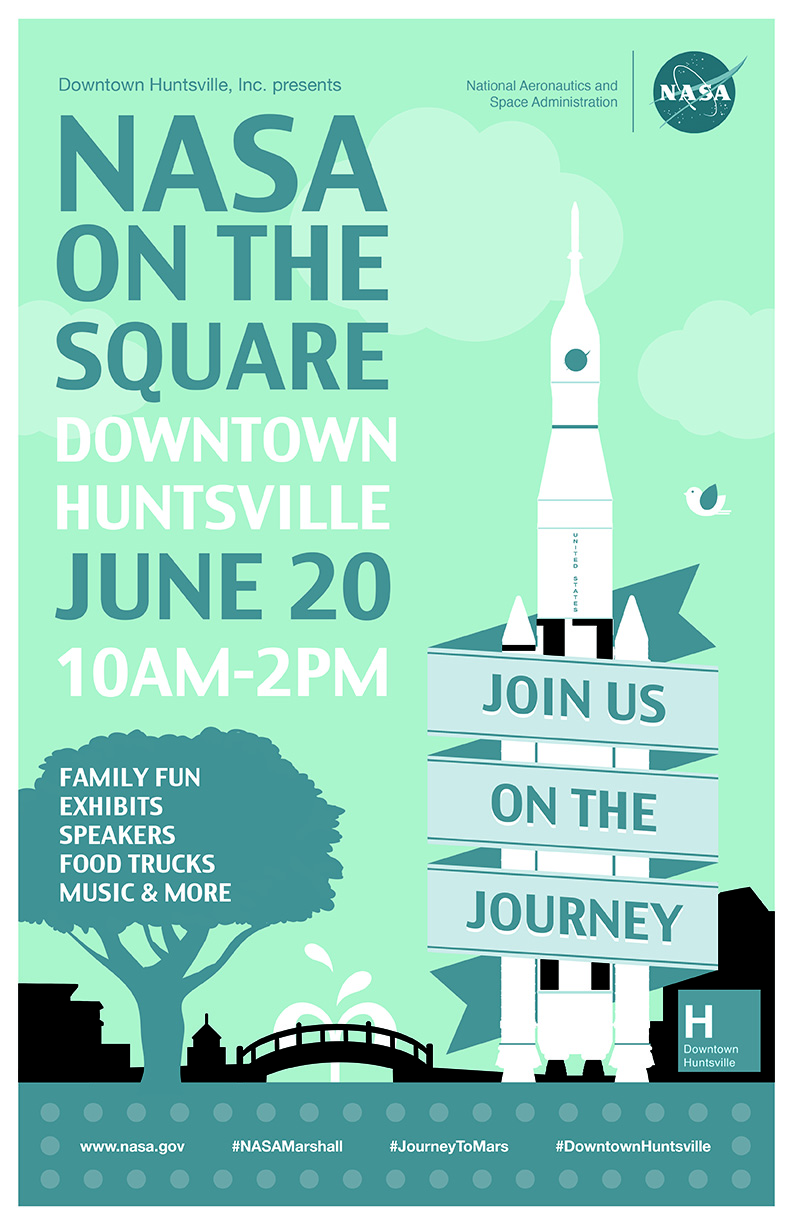
Looking for some fun on June 20? Come on down to NASA on the Square! NASA’s Marshall Space Flight Center is bringing its “open house” and 55th anniversary celebration to the streets of downtown Huntsville. NASA on the Square will take over the historic square around the Madison County Courthouse to salute the Huntsville community’s love for all things space. The Marshall Center is partnering with Downtown Huntsville, Inc. to create a fun, space-themed street festival with family activities, exhibits, food trucks, speakers, music and more. Visitors can journey through the wonders of space, see our missions and projects and speak with the engineers and scientists working on them. This year’s theme is “Join Us on The Journey.” The event will take place from 10 a.m. to 2 p.m. It is free and open to the public. (NASA/MSFC/Kevin Obrien)
New Data On Plutonian Moons Featured On ‘This Week @NASA’
The behavior of moons orbiting Pluto were featured in the latest edition of “This Week @NASA,” a weekly video program broadcast nationwide on NASA-TV and posted online.
Data from NASA’s Hubble Space Telescope show two of Pluto’s moons, Nix and Hydra, are wobbling about unpredictably. The moons are in this state, presumably because they are located in the constantly shifting gravitational field that exists between Pluto and its largest moon Charon. Scientists believe Pluto’s other two moons, Kerberos and Styx, also are likely experiencing effects of that gravitational instability.
These new discoveries are being used to plan science observations for NASA’s New Horizons spacecraft’s flyby of Pluto in mid-July. The New Horizons spacecraft is part of NASA’s New Frontiers program and is managed by NASA’s Marshall Space Flight Center.
View this and previous episodes at “This Week @NASA” or at https://www.youtube.com/user/NASAtelevision.



























